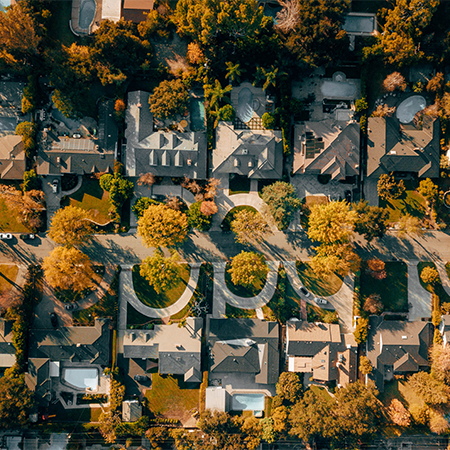Private wealth has always played a significant role in real estate markets around the world. We examine how wealth driven by the new economy has shifted the focus of demand, with vibrant tech environments such as San Francisco and Hangzhou seeing high price growth, and consider the location of the prime markets that will evolve to capture the next wave of wealth generation.
Even as those markets evolve and new asset classes come to the fore, it continues to do so. According to data from Real Capital Analytics, private investment in global commercial real estate averaged more than $615 billion in the four years to the end of 2020, some 36% of all sums invested.
But it is in the world’s prime residential markets that the fortunes of global wealth and property are most intertwined and interconnected.
A source and store of wealth
Residential property has been both an important store and source of wealth among the 1% of the world’s population with net assets of over $1 million; the high net worth individuals (HNWIs) who account for 43% of all global wealth, according to the Credit Suisse Global Wealth Report.
This dual role of residential property, in both creating and holding wealth, is well illustrated in the UK. We estimate that, across a country that comprises less than 0.2% of the world’s land mass, there are 563,000 £1 million+ homes with a combined asset value of £1.15 trillion. Such a store of private wealth reflects the decades of inflation-busting house price growth, seen over the second half of the 20th century and earlier part of the 21st century.
But as is the case in most corners of the world, the distribution of the UK’s high-value homes also reflects where the growth in wealth has been seeded.
Some 54% of these £1 million+ homes are located in London and a further 22% in the South East of England. Indeed, there are as many £1 million homes in the single London borough of Wandsworth – the location of choice to raise a family for those who have made their money in the city’s financial and business services sector – as there are across the whole of the North of England, Wales and Scotland combined.
Evolving patterns of wealth generation
Looking more widely across the globe, as patterns and sources of domestic wealth generation have evolved, so too have the demands on different prime residential markets. “We have seen a number of long-established prime housing markets appear to hit maturity, some adjusting to a changing profile of market demand and others growing rapidly as their economies have provided the fuel for rapid wealth appreciation,” says Alex Christian, Director, London Private Office, Savills.
This is perhaps best exemplified by the experiences of the US and China. The US remains home to by far the greatest number of HNWIs, some 39% of the world’s total according to Credit Suisse. Here, for every 1,000 head of population, 76 have wealth of at least US$1m. Their numbers grew by 30% over the period from 2014 to 2019.
Yet in the five years to the end of 2020, prime property prices in New York, the financial capital of North America, have eased back by -7%. High levels of new supply of top-end properties have taken time to be absorbed by market demand. But equally, the recent growth in wealth has been driven more by the new than the old economy, shifting the focus of demand on the country’s prime housing stock.
This is reflected by the fact that in San Francisco (where the tech boom has created the world’s highest concentration of billionaires per head of population according to Wealth-X), prime property prices have risen by 15% over the same period.
If we shift our gaze across continents to China, we see that there are less than a quarter of the number of HNWIs in a country with a total population four times the size of the US. However, their numbers have grown by a staggering 277% over the five years to 2019.
And that has supported strong growth in rapidly maturing prime housing markets. In the past five years, prime property prices in Beijing (some 11,000km from New York) have risen by 39%. But, providing yet another reminder of the power of the new generators of wealth, in Hangzhou, a vibrant tech environment has contributed to even higher price appreciation of 60% during that period.
“The expansion of mortgage finance combined with the pace of growth in the economy have meant the Chinese property market has been a very strong wealth generator in its own right over the past two decades,” says James Macdonald, Head of Research, Savills China.
The effect of the Covid-19 pandemic
So, if both changing geographical and sectorial trends in wealth generation are underpinning patterns of price growth across the global prime residential markets, to what extent has the pandemic affected this?
While the International Monetary Fund estimates that output in the global economy contracted by -3.5% in 2020, any hit to the total wealth of the high net worth, ultra-high net worth and billionaire communities appears to have been remarkably short lived.
Credit Suisse estimates that, while there were different impacts in different countries, over the six months to the end of June 2020 the total number of global HNWIs fell by just 0.11%, while the number of ultra HNWIs slipped by just 122 in number (in a community of more than 175,000). And by the end of 2020 those with wealth of between $5 million and $30 million had risen by 1.3%, according to Wealth-X.
Meanwhile, in their Billionaire Insights Report 2020, called Riding the Storm, UBS estimated that the total wealth of those at the very top of the wealth pyramid hit a new high of $10.2 trillion by July 2020. That, they say, reflected a V-shaped rebound in asset prices and strong continued wealth creation among the ‘innovators and disrupters’, most common in sectors such as technology and life sciences.
Given particularly strong growth in the billionaire populations of China and India, the Hurun Global Rich List 2021 indicates that this billionaire wealth had risen even further by the year end, while in April 2021 Forbes reported that the number of global billionaires increased by 660 in 2020.
Prime values
Savills prime residential world cities index suggests that, on average, prices across the global real estate markets followed a similar pattern, with prices ending the year marginally higher (+0.5%) than at the beginning.
Again, this average hides significant country by country and city by city variation. Whereas prices in Singapore fell by 3.4%, in Tokyo they rose by 2.4%. And while values in London remained broadly flat, they rose by 6.4% in the severely supply- constrained markets of Berlin.
Where the pandemic has hadan impact has been on what HNWIs and UHNWIs have wanted from their primary residences and second homes. Justin Marking, Head of Global Residential, Savills describes it succinctly: “The desire for more space, both inside and out, has driven a surge in activity in commuter and lifestyle relocation markets, whether that is a rush to buy in the Hamptons in New York, the Côte d’Azur in France or the Cotswolds in England.”
Race to the top
The higher you climb the wealth pyramid, the more residential property acquires the attributes of a true luxury asset. So, the decision to purchase becomes more discretionary and the ownership profile more international.
Accordingly, with international travel largely put on hold, many of the globe’s super-prime markets did not benefit from the same surge in activity that was seen in some other parts of the prime market, where needs-based buyers are more prevalent. “The flip side of that has been a growing pool of pent-up demand,” says Alex Christian.
In the markets of prime Central London, activity in the £5 million+ market was sustained by a combination of domestic buyers, resident non-doms and those overseas buyers with representation in the UK in 2020 and the first half of 2021.
But, in a market that peaked in 2014 and looks good value on the world stage, we are forecasting price growth of more than 20% in the next five years as a flow of international money returns to the market.
There has been a similar picture in Monaco. Prices fell marginally over 2020 but transactions fell by 39% for properties above €10 million.
“Low tax, good amenities, a central position in Europe and an excellent health system have long underpinned Monaco’s appeal to the ultra-high net worth community,” says Irene Luke, Co-Head of Savills Monaco. “Restricted supply has also made it a secure market in terms of capital preservation. None of this looks likely to change.”
Ultimately the fortune of such mature, well-established super-prime markets will be determined by their ability to sustain their appeal to an increasingly diverse and evolving community of those in the highest tiers of the wealth pyramid.
However, in all regions of the globe, the prime markets that deliver the highest future growth will be those that capture the next wave of wealth generation; the tech and science cities that are increasingly becoming the focus of wider property investment.



